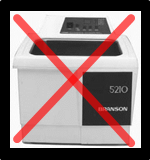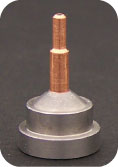Mitegen Crystal Mounts and Loops环
Crystal Mounts and Loops
Simplify crystal harvesting, and obtain the best possible data from your crystals, using the most advanced lithographic cryo-loops available.
Composed of X-ray transparent material, crystals can be mounted directly on the loops, reducing excess fluid, preventing damage, and making getting the crystals out of the drop easier.
简化晶体收获,并获得最好的数据,从你的晶体,使用最先进的光刻低温循环可用。
晶体由x射线透明材料组成,可以直接安装在回路上,减少多余的液体,防止损坏,并使晶体更容易从液滴中取出。
The polymer is unoriented, so the background scatter does not show the sharp peaks of competing mounts, and has the lowest possible birefringence.
Curving the tip by wrapping its base around the rod makes it rigid, and provides a scoop-like action in retrieving samples. The tip can also flex and bend flat against e.g., a well or glass slide, to dislodge and then slip under a sample.
A wicking aperture draws excess liquid away from the sample, reducing background scatter and allowing faster sample cooling for cryocrystallography.
Since 2008, MicroMounts™ (and all of our other products) have been made using the most mechanically robust unoriented polymer available. With proper care – especially during cleaning – each MicroMount™ can be used to harvest and measure dozens of crystals.
Extremely easy to use, novices can be mounting samples in minutes. MicroMounts™ make your crystallography pipeline more efficient by maximizing the odds of successful mounting, cooling and data collection.
MicroMounts™ 是世界上用于回收和安装蛋白质晶体、病毒晶体和小分子/无机晶体的最高性能工具。它们还可用于处理各种小型易碎样品,包括生物、考古和矿物样品。MicroMounts™ 与所有标准 X 射线硬件兼容,可插入 0.7 毫米自动铅笔或显微操作器中,以便于操作。
Micromounts™ 由薄聚合物尖端组成,连接到斜面非磁性 0.025 英寸(0.64 毫米)直径不锈钢杆。其专利设计完美结合了 X 射线和光学透明度、机械刚性和灵活性以及精密尺寸。
该聚合物是无取向的,因此背景散射不会显示竞争支架的尖峰,并且具有尽可能低的双折射。
通过将其基部缠绕在杆上来弯曲尖端,使其变得坚硬,并在取回样品时提供类似勺子的动作。尖端还可以相对于例如孔或载玻片平直地弯曲和弯曲,以移动并然后滑到样品下方。
芯吸孔将多余的液体从样品中吸走,减少背景散射,并允许更快地冷却样品以进行冷冻晶体学。
自 2008 年以来,MicroMounts™(以及我们所有其他产品)均采用现有机械性能最坚固的无取向聚合物制成。通过适当的保养——尤其是在清洁过程中——每个 MicroMount™ 都可以用来收获和测量数十个晶体。
使用极其简单,新手可以在几分钟内安装样品。MicroMounts™ 通过最大限度地提高成功安装、冷却和数据收集的几率,使您的晶体学流程更加高效。
MicroMounts™ consist of a thin microfabricated polyimide film attached to a solid non-magnetic 0.025″ (0.64 mm) stainless steel rod.
- Films
-

Polyimide:
Used in Kapton® tape, which is employed for X-ray transparent windows on X-ray beam lines. Has low atomic number (Z) constituents and low density, and produces less background scatter than e.g., nylon. Optically transparent with an orange-gold hue.
Film Curvature:
Obtained by wrapping polyimide film around the steel rod. Provides excellent stiffness even with very thin (7.5 micrometer) films, and a convenient, scoop-like action in retrieving and handling samples. - Film Pattern
-

Sample aperture (A) sizes from 10 to 600 micrometers, with minimal polyimide width (B) around the aperture to minimize background scatter in all orientations.
Wicking hole (C) connected via drainage channel (D) to the sample aperture. Hole size is compatible with size 15 or XF paper wicks. “Fountain-pen”-like design allows easier removal of excess liquid – without ever touching the sample with the wick.
Alignment cross (E) located a fixed distance from the center of the sample aperture. Allows easy automated alignment of the sample aperture (A).
Sample aperture size code (F) around the alignment cross. Allows automated recognition of mount design and of aperture and sample size, which determines boundaries of aperture (to be avoided), required alignment tolerance, and area of sample available to be scanned for optimum diffraction. Initial beam size can then be automatically selected. Aperture size (G) in μm can be read directly off the mount.Orientation mark (H) allows the front and back of the mount to be automatically distinguished.
- Rods
- Solid 316 non-magnetic stainless steel rods. Diameter of 0.025″ (0.64 mm) is compatible with all standard goniometer bases / caps, and can be inserted and held in 0.7 mm mechanical pencils. Rods will not be pulled out or trapped by magnets in tools or in automounting hardware. Available in four standard lengths: 11 mm, 19 mm, SPINE, and 25 mm. The 11, 19 and 25 mm rod lengths give rod base-to-sample center distances comparable to those of nylon loops mounted in 10, 18, and 24 mm rods, respectively. Custom rod lengths available on request.
Unlike competing mounts in hollow rods, our solid rods will not suck up samples and liquid.
Beveled at film end. Allows good visibility of the sample for a wider range of rod orientations during sample retrieval than unbeveled rods.
Can be cut using spring-steel-compatible pliers/cutters to any desired length. Can be easily bent to place sample in desired orientation. Fit all standard bases.
MicroMounts™ 由附着在实心非磁性 0.025 英寸(0.64 毫米)不锈钢棒上的微加工聚酰亚胺薄膜组成。
- 聚酰亚胺:
用于 Kapton® 胶带,用于 X 射线光束线上的 X 射线透明窗口。具有低原子序数 (Z) 成分和低密度,并且比尼龙等产生更少的背景散射。光学透明,呈橙金色色调。薄膜曲率:
通过将聚酰亚胺薄膜缠绕在钢棒上而获得。即使对于非常薄(7.5 微米)的薄膜也能提供出色的刚度,并在检索和处理样品时提供方便的勺状动作。 - 薄膜图案
-

样品孔径 (A) 尺寸为 10 至 600 微米,孔径周围具有最小的聚酰亚胺宽度 (B),以最大限度地减少所有方向的背景散射。
芯吸孔 (C) 通过排水通道 (D) 连接至样品孔。孔尺寸与 15 号或 XF 号纸芯兼容。“钢笔”式的设计可以更轻松地去除多余的液体,而无需用吸芯接触样品。
对准十字 (E) 位于距样品孔径中心固定距离的位置。可以轻松自动对准样品孔径 (A)。
对准十字周围的孔径尺寸代码 (F) 示例。允许自动识别安装设计以及孔径和样品尺寸,从而确定孔径边界(要避免)、所需的对准公差以及可用于扫描以获得最佳衍射的样品区域。然后可以自动选择初始光束尺寸。 孔径尺寸 (G)(以微米为单位)可以直接从安装座上读取。方向标记 (H) 可以自动区分安装座的正面和背面。
- 棒
- 实心 316 无磁不锈钢棒。直径为 0.025 英寸(0.64 毫米),与所有标准测角仪底座/盖子兼容,并且可以插入并固定在 0.7 毫米自动铅笔中。杆不会被工具或自动安装硬件中的磁铁拉出或卡住。有四种标准长度可供选择:11 毫米、19 毫米、SPINE 和 25 毫米。11、19 和 25 毫米的杆长度使杆底座到样品的中心距离分别与安装在 10、18 和 24 毫米杆中的尼龙环的距离相当。可根据要求提供定制杆长度。
与空心棒中的竞争安装座不同,我们的实心棒不会吸收样品和液体。
薄膜末端斜切。与无斜角的杆相比,在样品检索过程中,可以在更广泛的杆方向范围内实现良好的样品可视性。
可以使用弹簧钢兼容的钳子/切割器切割成任何所需的长度。可以 轻松弯曲 以将样品放置在所需的方向。适合所有标准底座。
- 聚酰亚胺:
清洁 MiTeGen 工具的最佳且最简单的方法是将其浸泡在含有清洁剂的溶液中。当安装在 MiTeGen 底座支架上时,可以一次清洁大量安装件。
为了去除蛋白质残留物,我们推荐使用含酶洗涤剂,例如 Alconox 的 Tergazyme 或 Decon 的 Contrex EZ;否则,标准实验室玻璃器皿/塑料器皿清洁剂(例如 Alconox)就足够了。我们建议最初浸泡 10 到 15 分钟,然后在水浴中快速冲洗以去除洗涤剂。所需浸泡的最佳长度将取决于安装件或工具上残留的残留材料(蛋白质等)以及自上次使用以来的时间。使用后越早清洁它们就越容易。
MiTeGen 的底座支架 使清洁变得容易:
 |
•将包含环的底座装入支架中。 •然后将支架放入塑料或玻璃桶或盘中。 •按照洗涤剂盒上的说明混合含有洗涤剂的溶液。 •然后将清洁剂倒入桶中,直至液位升至底座支架上的填充线。这将确保环形尖端被浸泡,同时保持底座的不锈钢部分远离溶液并防止腐蚀。 |
| 在极少数情况下,当浸泡无法去除沉积物时,您可以使用中号 (M) 或细号 (F) 纸芯。为了最方便地操作,请使用剃须刀刀片从最宽端切掉,使其直径适合 0.7 毫米自动铅笔。然后将另一端浸入水、清洁剂溶液或异丙醇中,并从底部到尖端轻轻抚摸聚合物。 |
 |
处理注意事项:
MiTeGen 的 MicroMounts™、MicroLoops™ 和其他工具的微加工尖端由最耐用的无取向聚合物制成,可实现超低背景 X 射线散射。与尼龙等定向纤维相比,如果使用不当,非定向聚合物更容易撕裂或切割。请按照以下说明操作,以最大限度地延长我们产品的使用寿命。
1. 切勿 用手触摸尖端。始终沿销轴而不是尖端使用我们的重型镊子。 |
2. 切勿 将斜面钢销推入尖端抵靠坚硬的表面。
 |
3. 应做: 将吸头固定在 MiTeGen 底座支架中,并浸泡在清洁剂中来清洁吸头。
请勿: 长时间超声处理。超声处理几分钟左右就可以了,但长时间超声处理可能会损坏一些尖端。使用含酶洗涤剂,无需超声处理。

4. 应做: 使用 MiTeGen 纸芯去除顽固残留物
请勿: 使用棉签或泡沫头棉签。棉签可以捕获并撕裂聚合物。
5. 清洁后要干燥吸头,请让其风干。您可以短暂浸入异丙醇中以加快干燥速度。 避免吹干。如果喷嘴距离尖端太近,产生的湍流阻力可能会损坏尖端。喷嘴距尖端至少 20 厘米。

 Convenient kits of compatible assemblies of MiTeGen recommended products
Convenient kits of compatible assemblies of MiTeGen recommended products













